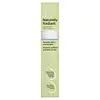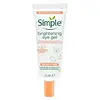What's inside
What's inside
 Key Ingredients
Key Ingredients

 Benefits
Benefits

 Concerns
Concerns

No concerns
 Ingredients Side-by-side
Ingredients Side-by-side

Water
Skin ConditioningGlycerin
HumectantParaffinum Liquidum
EmollientButyrospermum Parkii Butter
Skin ConditioningOctyldodecanol
EmollientGlyceryl Stearate Se
EmulsifyingDimethicone
EmollientIsohexadecane
EmollientPolyglyceryl-3 Methylglucose Distearate
EmulsifyingBetaine
HumectantStearyl Alcohol
EmollientStearic Acid
CleansingSaccharomyces Cerevisiae Extract
Skin ConditioningRhodiola Rosea Root Extract
EmollientSapindus Mukorossi Fruit Extract
Skin ConditioningCaesalpinia Spinosa Gum
Skin ConditioningActinidia Chinensis Fruit Extract
EmollientNelumbium Speciosum Flower Extract
Skin ConditioningMorus Nigra Leaf Extract
Skin ConditioningTocopheryl Acetate
AntioxidantLecithin
EmollientTocopherol
AntioxidantAscorbyl Palmitate
AntioxidantPentylene Glycol
Skin ConditioningPhenoxyethanol
PreservativeEthylhexylglycerin
Skin ConditioningPotassium Sorbate
PreservativeSodium Benzoate
MaskingCarbomer
Emulsion StabilisingXanthan Gum
Emulsifying2-Bromo-2-Nitropropane-1,3-Diol
PreservativeSodium Hydroxide
BufferingCitric Acid
BufferingDisodium EDTA
Water, Glycerin, Paraffinum Liquidum, Butyrospermum Parkii Butter, Octyldodecanol, Glyceryl Stearate Se, Dimethicone, Isohexadecane, Polyglyceryl-3 Methylglucose Distearate, Betaine, Stearyl Alcohol, Stearic Acid, Saccharomyces Cerevisiae Extract, Rhodiola Rosea Root Extract, Sapindus Mukorossi Fruit Extract, Caesalpinia Spinosa Gum, Actinidia Chinensis Fruit Extract, Nelumbium Speciosum Flower Extract, Morus Nigra Leaf Extract, Tocopheryl Acetate, Lecithin, Tocopherol, Ascorbyl Palmitate, Pentylene Glycol, Phenoxyethanol, Ethylhexylglycerin, Potassium Sorbate, Sodium Benzoate, Carbomer, Xanthan Gum, 2-Bromo-2-Nitropropane-1,3-Diol, Sodium Hydroxide, Citric Acid, Disodium EDTA
Water
Skin ConditioningPropanediol
SolventNiacinamide
SmoothingGlycerin
HumectantTetrahydroxypropyl Ethylenediamine
Caprylyl Glycol
EmollientPhenoxyethanol
PreservativeCarbomer
Emulsion StabilisingSaccharide Isomerate
HumectantCitric Acid
BufferingHydrolyzed Lupine Protein
Skin ConditioningDisodium EDTA
Medicago Sativa Seed Extract
Skin ConditioningTocopheryl Acetate
AntioxidantSodium Ascorbyl Phosphate
AntioxidantSodium Citrate
BufferingEthylhexylglycerin
Skin ConditioningZingiber Officinale Root Juice
Skin ConditioningWater, Propanediol, Niacinamide, Glycerin, Tetrahydroxypropyl Ethylenediamine, Caprylyl Glycol, Phenoxyethanol, Carbomer, Saccharide Isomerate, Citric Acid, Hydrolyzed Lupine Protein, Disodium EDTA, Medicago Sativa Seed Extract, Tocopheryl Acetate, Sodium Ascorbyl Phosphate, Sodium Citrate, Ethylhexylglycerin, Zingiber Officinale Root Juice
Ingredients Explained
These ingredients are found in both products.
Ingredients higher up in an ingredient list are typically present in a larger amount.
Carbomer is a polymer of acrylic acid. Its main role is to create a gel consistency.
A high amount of carbomer can cause pilling or balling up of products. Don't worry, most products contain 1% or less of carbomer.
Citric Acid is an alpha hydroxy acid (AHA) naturally found in citrus fruits like oranges, lemons, and limes.
Like other AHAs, citric acid can exfoliate skin by breaking down the bonds that hold dead skin cells together. This helps reveal smoother and brighter skin underneath.
However, this exfoliating effect only happens at high concentrations (20%) which can be hard to find in cosmetic products.
Due to this, citric acid is usually included in small amounts as a pH adjuster. This helps keep products slightly more acidic and compatible with skin's natural pH.
In skincare formulas, citric acid can:
While it can provide some skin benefits, research shows lactic acid and glycolic acid are generally more effective and less irritating exfoliants.
Most citric acid used in skincare today is made by fermenting sugars (usually from molasses). This synthetic version is identical to the natural citrus form but easier to stabilize and use in formulations.
Read more about some other popular AHA's here:
Learn more about Citric AcidDisodium EDTA plays a role in making products more stable by aiding other preservatives.
It is a chelating agent, meaning it neutralizes metal ions that may be found in a product.
Disodium EDTA is a salt of edetic acid and is found to be safe in cosmetic ingredients.
Learn more about Disodium EDTAEthylhexylglycerin (we can't pronounce this either) is commonly used as a preservative and skin softener. It is derived from glyceryl.
You might see Ethylhexylglycerin often paired with other preservatives such as phenoxyethanol. Ethylhexylglycerin has been found to increase the effectiveness of these other preservatives.
Glycerin is already naturally found in your skin. It helps moisturize and protect your skin.
A study from 2016 found glycerin to be more effective as a humectant than AHAs and hyaluronic acid.
As a humectant, it helps the skin stay hydrated by pulling moisture to your skin. The low molecular weight of glycerin allows it to pull moisture into the deeper layers of your skin.
Hydrated skin improves your skin barrier; Your skin barrier helps protect against irritants and bacteria.
Glycerin has also been found to have antimicrobial and antiviral properties. Due to these properties, glycerin is often used in wound and burn treatments.
In cosmetics, glycerin is usually derived from plants such as soybean or palm. However, it can also be sourced from animals, such as tallow or animal fat.
This ingredient is organic, colorless, odorless, and non-toxic.
Glycerin is the name for this ingredient in American English. British English uses Glycerol/Glycerine.
Learn more about GlycerinPhenoxyethanol is a preservative that has germicide, antimicrobial, and aromatic properties. Studies show that phenoxyethanol can prevent microbial growth. By itself, it has a scent that is similar to that of a rose.
It's often used in formulations along with Caprylyl Glycol to preserve the shelf life of products.
Tocopheryl Acetate is AKA Vitamin E. It is an antioxidant and protects your skin from free radicals. Free radicals damage the skin by breaking down collagen.
One study found using Tocopheryl Acetate with Vitamin C decreased the number of sunburned cells.
Tocopheryl Acetate is commonly found in both skincare and dietary supplements.
Learn more about Tocopheryl AcetateWater. It's the most common cosmetic ingredient of all. You'll usually see it at the top of ingredient lists, meaning that it makes up the largest part of the product.
So why is it so popular? Water most often acts as a solvent - this means that it helps dissolve other ingredients into the formulation.
You'll also recognize water as that liquid we all need to stay alive. If you see this, drink a glass of water. Stay hydrated!
Learn more about Water